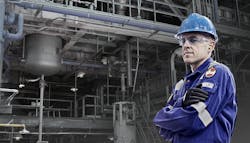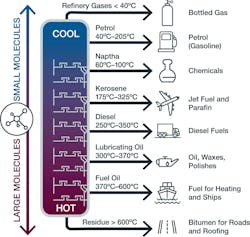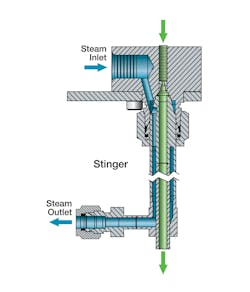Sampling high-viscosity fluids and safely maximizing your refinery's processes
Key Highlights
- Simplified system design minimizes components and bends, reducing the risk of complications and maintaining sample integrity.
- Proper placement of sampling points, avoiding dead legs, ensures accurate samples and prevents contamination or blockages.
- Collaborate with experienced suppliers and field engineers to develop safe, effective sampling systems tailored to high-viscosity fluids.
Maximizing the value of a modern refinery's complete production processes is a complex challenge, especially taking into consideration the wide range of products and byproducts created during operations. Each refined material has its own unique characteristics for handling, storage and quality sampling.
Take bitumen, for example: Resulting from the vacuum distillation process of crude oil, this dense, large-molecule liquid can be combined with aggregate to make asphalt. From roads to runways to roofs, asphalt plays an important role in many applications across the construction industry. It is not a high-cost product, but bitumen can still add significant profit to a refinery's production due to the low cost of the raw material and the fact that it is a byproduct of an existing process.
Successfully capturing the value of bitumen means performing regular and reliable sampling for quality and consistency, just like any other refined oil product. And the process of grab sampling needs to be performed in accordance with established best practices using reliable equipment. Accurate analysis of your processes depends directly on the integrity of the sample. High-viscosity fluids such as bitumen present specific challenges in grab sampling that require specialized attention to deliver accuracy and safety under difficult conditions.
These are not just details to pay attention to for their own sake. You are protecting workers from the risk of severe injury, protecting sizable investments in equipment and systems, and protecting customer relationships built on delivering the quality of refined products they expect. Which of those can you afford to let slide?
The problem of solidification
A common characteristic of high-viscosity fluids is their tendency to solidify at temperatures below a certain threshold — usually at least 20°C/68°F above their pour temperature. This solidification can lead to clogs and downtime. Once a system solidifies, achieving proper flow again can be difficult: You will need to remelt all the media, and then address the inevitable cold spots as things heat up again. And the mechanical intervention of having technicians rod the lines can get messy and potentially dangerous, making things even more costly. Because high-viscosity fluids such as bitumen often require one-inch tubing lines, replacement parts are priced higher than those for smaller line sizes.
To help mitigate the chances of solidification, a high-viscosity grab sampling system needs to incorporate heating elements that will maintain viscous fluid flow. Additionally, it is important to maintain the proper temperature throughout the sampling apparatus to keep the fluid flowing from the lines through the dispenser and into the sample container. The simpler the design, the easier this becomes: Minimizing the number of extraneous components and tube bends will help keep a consistent temperature point. You could also include a stinger nozzle in the design. This component incorporates a steam line to provide a warming jacket that keeps the system media hot through its exit point.
Safe sampling at high heat
Operator safety is paramount when working with equipment at the temperatures required for successful high-viscosity fluid sampling. For instance, bitumen typically flows between 204°C/400°F and 260°F/500°F — temperatures which can instantaneously cause serious burns on contact. This makes it critical to ensure that all components comprising a sampling system are properly rated for the required high temperatures of the bitumen or other high-viscosity media. You will need to work closely with your supplier to be sure you are selecting the appropriately rated tube fittings, valves and other parts across the system.
With these severe burn hazards in mind, make sure your sampling container is made of the right material (typically metallic) and rated to handle the high temperatures. You should also equip your sampler with a “no bottle, no flow” mechanism. This prevents any fluid dispensing without a proper container in place for sample collection and helps avoid the potential for serious injury and hazardous material cleanup associated with an accidental discharge.
It is often also advisable to surround the sampling point with an enclosure to guard against hot fluid splashing during the sample process. You can steam-heat these enclosures to help keep the sample viscous and prevent clogging at the end point.
Seek simplicity and expertise
Sampling matters — a lot. It is how you validate the composition of your refined fluids, stay compliant with regulations and, ultimately, serve your customers with high-quality products while increasing your profitability. And as more industries bring analytical equipment online, it becomes more imperative for refineries to have quality sampling practices and systems in place.
In general, our experience over the years in working with customers to develop safe sampling systems for niche fluids like bitumen has led us to conclude that simplicity is key: The more complexity you introduce into the system, the greater your chances for complications and problems down the line. For instance, when designating the sampling location, you will want to avoid dead legs (spaces in the line like tees that can trap old sample material) upstream of the sampling container. This trapped material can compromise sample integrity or lead to clogs.
With all that is at stake, do not hesitate to ask your supplier for advice and best practices for designing, constructing and utilizing these critical sampling systems. Seek out resources such as field engineers and teams with experience in high-viscosity fluid sampling. Following the right grab sampling procedures, using the right equipment and having a safe, optimized design will keep your refinery's fluid processes flowing safely and efficiently.
About the Author
Matt Dixon
Global Technical Lead for Swagelok Company
Matt Dixon, Global Technical Lead for Swagelok Company, began his career with the company in 1998 as an engineering co-op student and has worked as an assembly, welding, and manufacturing engineer in an array of capacities since, supporting the production of various product lines and the designing and building of assembly and test equipment. He has extensive experience in developing, testing, and troubleshooting sampling systems.


